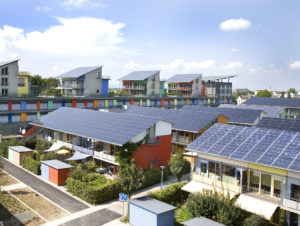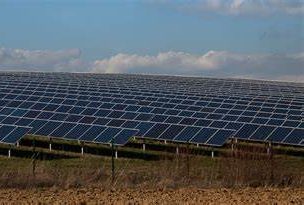Description
For all new construction, require on-site solar PV to be installed, or at a minimum require that the building is “solar-ready”. The PV system can be installed on the roof and/or ground mounted. For houses, the system should be sized so it annually produces at least 25% but no more than 110% (if grid-connected) of the building’s anticipated annual electricity consumption. For non-residential buildings, panels and related equipment must occupy at least 20% of the total rooftop space. Panels must face within 45 degrees of solar south on sloped roofs.
This requirement will benefit both building owners and other residents. Peak need for electricity is at mid-day on summer days when air conditioning demand is highest, and often results in more air pollution when dirtier generators are spun up to meet grid demand. This peak demand is matched by peak production from south-facing rooftop solar panels, so will reduce the amount of air pollution from the dirtier “peaking plants.” Also, building owner electric utility bills will be at least reduced and can even be eliminated, depending on consumption patterns and system size. Building owners can expect increased resale value too; for each $1,000 saved in utility bills, a buyer of a home will pay on average an additional $8,728 for the home.

1
2
3
4
Implementation Phases
All new residential construction must be at least solar-ready with conduit for electrical lines from attic to the location of the electrical pane. Consideration must be given to the orientation of the building and roof structure to enable solar panel installation and maximize energy production.
All new residential construction must have solar panels installed.
Require new non-residential buildings to have solar panels installed. This could be for either on-site consumption or as the host for a solar project that serves the community or other buyers (via PPA or other transaction type.)
Suitable existing buildings install solar panels.
Challenges
On-site PV, such as at residential rooftops, are an underutilized resource, but are not sufficient to offset all the load from this sector in the municipality. Grid-scale commercial solar plants are also needed.
Upfront costs for a new solar PV system can be significant and not all solar installers provide lease options. Tax incentive policy changes may reduce the out of pocket costs for solar system installation, but there are limits to who can qualify.
In established neighborhoods, mature trees may block rooftops from direct sunlight.
Example Municipalities
Several municipalities have already implemented this action…
- Pinecrest, Florida requires new construction or remodeling that exceeds 50% of appraised building value to set forth a design indicating how the roof will be built to accommodate solar electric or solar hot water
- El Paso, Texas adopted Appendix U from the 2015 International Residential Code (IRC) for townhouses, one and two family dwellings and multiple single family dwellings, with no less than 600 square feet of roof space, to have a section of the roof reserved for future installation of PV or solar hot water panels
- New York City Housing Authority currently has a program underway to develop hundreds of rooftops as hosts for community solar development
Greenhouse Gas (GHG) Reductions
Data
Existing number of residential units in Bethlehem, NY: 14485 [Town of Bethlehem Demographic and Growth Analysis 1991-2018 , chart 1]
Existing number of commercial units in Bethlehem, NY: 625 [Town of Bethlehem Demographic and Growth Analysis 1991-2018, chart 20]
Total carbon emission from commercial and residential buildings in Bethlehem, NY: 91220 Metric Ton CO2e [Bethlehem, NY 2010 Greenhouse Gas Emissions Inventory, Table 1]
Average of new residential buildings from 2010 to 2017:65 buildings [Town of Bethlehem Demographic and Growth Analysis 1991-2018 , p. 9]
Average of new commercial buildings from 2000 to 2012: 7 buildings [ Town of Bethlehem Demographic and Growth Analysis 1991-2018 , p. 37]
Assumptions
For this strategy it is assumed that PV are installed for all for new commercial and residential constructions.
Methodology
We calculated the:
- Average emission per commercial and residential unit per year in Bethlehem: 6.3 Metric Ton CO2 emission.
- CO2e reduction starting with phase wise implementation considering new residential and commercial structures use on site PV’s.
Result
455 metric tons CO2 e per year is reduced by installing onsite PV’s on all new constructions of residential and commercial units.
This results in MODERATE GHG emissions reductions.

Climate Smart Communities (CSC) & Clean Energy Communities (CEC) Link
No direct counterpart exists for this action in the CEC and CSC frameworks, but the NYStretch building code includes a requirement for solar readiness. Municipalities that adopt the NYStretch building code can:
CEC Actions:
- Access 1200 CEC points and also action grants up to $50k through CEC’s NYStretch Energy Code Action.
CSC Actions:
- After completing the above CEC action, municipalities can also earn 10 CSC points through CSC’s PE6 Action: NYStretch Energy Code.
- Also, CSC’s PE4: Solar Energy Installation Action is related. Under that action, municipalities can earn points for planning and installing solar panels on government buildings.

Co-benefits
There are multiple co-benefits to completing this action, including:
- Supports transition to net-zero construction.
- Increases electric grid resilience on high demand days.
- Improves resilience when combined with battery storage.
Resources
The Department of Energy created a checklist to ensure one’s home is ready to switch to PV:
DOE Zero Energy Ready Home PV-Ready Checklist.
California also made its own checklist for solar ready housing.
California Energy Commission: Solar PV Systems and Solar Ready site
Utilize the National Renewable Laboratory Solar Ready Buildings Planning Guide published in 2009.
The following municipalities require buildings be solar-ready:
- Pinecrest, Florida. Requires new construction or remodeling that exceeds 50% of appraised building value to set forth a design indicating how the roof will be built to accommodate solar electric or solar hot water.
- New York City Housing Authority. Program underway to develop hundreds of rooftops as hosts for community solar development. https://nysolarmap.com/nyc-solar/nycha-25-mw-solar-program/
- El Paso, Texas. Adopted Appendix U from the 2015 International Residential Code (IRC) for townhouses and one and two family dwellings and multiple single family dwellings with no less than 600 square feet of roof space have a section of the roof reserved for future installation of PV or solar hot water panels.
- Salt Lake City, Utah. The use of renewable energy strategies is encouraged in all new developments. In the event that renewable energy is not being implemented in the project, the developer and architect are to anticipate the introduction of solar technologies in the future. The building design is to be “solar ready” so that renewable energy systems can be easily installed.
The following locations require that buildings have solar panels installed:
- State of California. As of January 1, 2020, all new single or multi family homes up to three stories tall are required to have solar panels installed. Expected net savings on electricity cost is $40 per month, $500 per year.
- New York City. As of November, 2020, all roofs undergoing major construction in New York City are required to have solar panels, or green roofs, or a combination of both.
https://eyeonhousing.org/2019/04/how-much-are-buyers-willing-to-pay-for-energy-efficiency/
https://www.energy.gov/sites/prod/files/2015/05/f22/PV-Ready%20Checklist.pdf
https://www.energy.ca.gov/programs-and-topics/programs/building-energy-efficiency-standards/online-resource-center/sola
https://www.energy.ca.gov/programs-and-topics/programs/building-energy-efficiency-standards/online-resource-center/solar
https://www.nrel.gov/docs/fy10osti/46078.pdf
https://www.nyserda.ny.gov/All-Programs/Programs/NY-Sun/Communities-and-Local-Governments/Solar-Guidebook-for-Local-Governments
https://library.municode.com/fl/pinecrest/codes/code_of_ordinances/nodeId=C
OORVIPIFL_CH30LADERE_ART5ADRE_DIV._5.27ALENSYENC
https://up.codes/viewer/texas/irc-2015/chapter/U/solar-ready-provisions-detached-one-and-two-family-dwellings-multiple-single-fam#U



